Receiving the ‘Daughter of Maharashtra’ award: Sahiyo co-founder shares her experience
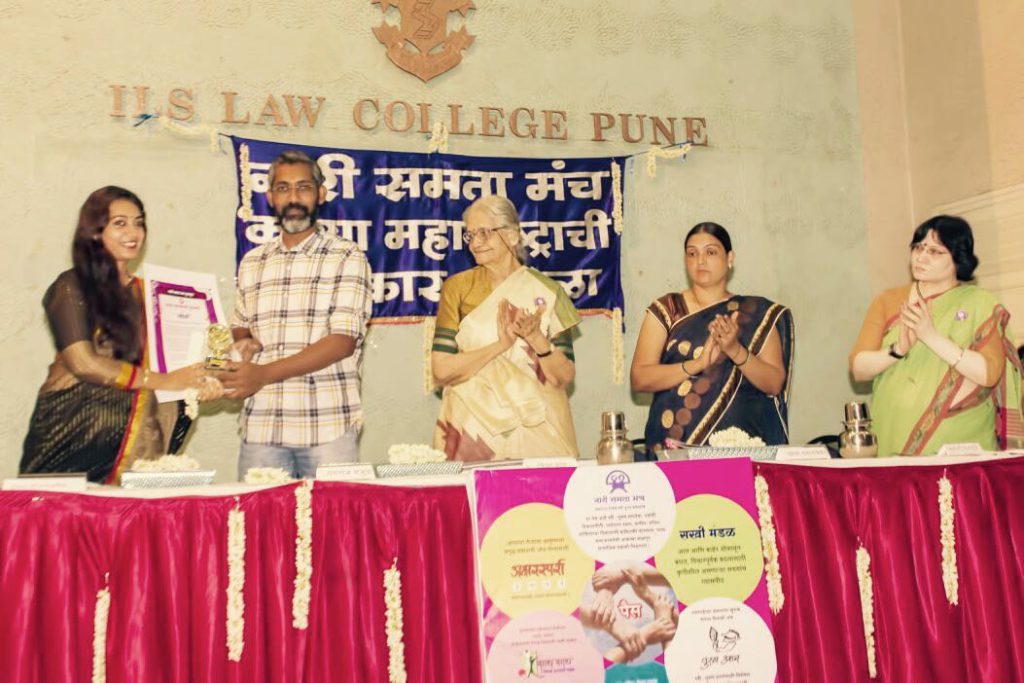
by Insia Dariwala On July 23, 2016, Sahiyo was felicitated with the very prestigious ‘Daughter of Maharashtra’ award for our continuous efforts in addressing FGM/C in India. Sahiyo co-founder Insia Dariwala, who received the award on behalf of Sahiyo at the ceremony in Pune, shares her experience here: The award, a brainchild of Nari Samata Manch, was given away by celebrated filmmaker Nagraj Manjule, of ‘Sairat’ fame. One of the oldest organisations in Pune, Nari Samta Manch has zealously been fighting for the cause of gender issues and Women’s Rights for the past 30 years. The ‘Daughter of Maharashtra’ award originated as a documented project through a book, and then went on to felicitate real life heroes, with not just a memento, but also a cash prize of Rs 10,000. It was also an honour to learn that Sahiyo was the last recipient of this award. The venue at ILS Law College was teeming with women from different walks of life, and rightly so, since the other recipient of this award was Chhaya Tamchekar, a brave woman who left a deep impact on me. Chhaya was awarded for her bravery in challenging the archaic laws of the ‘Jaat Panchayats’ (caste courts) in her village. Widowed at a very young age, Chhaya was declared a “characterless” woman, so that her property could be usurped by her in-laws. But that was not all. The Panchayat had ruled that Chhaya would have to take a test to prove her chastity, which involved walking naked in the village, with hot flour balls being thrown at her. Instead, she refused and fled the village with her two kids, took her case to the media and police, and finally with the help of an organisation fighting against superstitions, she was able to shut down 17 such kangaroo courts, and get justice for her and her children. Chhaya’s triumphs are worth celebrating as it resonates with the millions of women who have been brave enough to battle many such sadistic rituals, and traditions, in their part of the world. Today, Sahiyo is proud to be counted amongst those women, and we are grateful to an organisation like Nari Samta Manch, that recognises and applauds such efforts. Thank You Nari Samta Manch!
Sahiyo Receives ‘Daughter of Maharashtra’ Award from Nari Samata Manch

Nari Samata Manch has been working on gender issues for last 30 years. Gender-based violence is the core area of Nari Samata Manch work. The organization has institutionalized an award ‘Daughter of Maharashtra’ to honor women who have contributed significantly for the cause of gender equality. The name of the award is a byproduct of a documentary project that Nari Samata Manch undertook titled, ‘Daughters of Maharashtra’ which captured the contributions of women of Maharashtra in different fields. The Maharashtra Foundation funded the project and so this award was named after the foundation and the documentary. This year, Nari Smata Manch has felicitated ‘Sahiyo’ for its contributions to build a dialogue around the practice of khatna or FGC.
I’m A Survivor of Female Genital Cutting and I’m Speaking Out – As Others Must Too
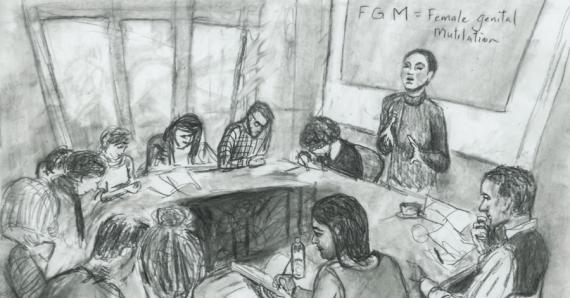
(This story originally appeared on the Guardian.com on February 8, 2016 and reappeared on the U.S. State Department’s official blog on June 1, 2016. It is republished here with permission). By Maryum Saifee I was sitting in an anthropology seminar at the University of Texas cramming for a final, only half-listening to a fellow classmate describe her research project. Female genital mutilation is the partial or total cutting of the external female genitalia for non-medical reasons,” she mechanically described. “The procedure typically take places when the girl is seven years old. The process is usually carried out by an older female relative. And once the ritual takes place, it is almost never discussed.” As she spoke, goosebumps began to form and I sat paralysed in my seat. Memories I had suppressed since childhood came flooding to the foreground. I was seven years old. My parents had sent my brother and me to visit family in India for two months. On a humid mid-summer afternoon, my dad’s sister decided to throw a party for my brother, celebrating his completion of the Qur’an. At the party, she pulled me aside, wielding a jumbo-sized Toblerone. She said that if I stayed on my best behaviour, I wouldn’t have to share it with anyone, including my brother. I was overjoyed. My aunt was a doctor. So when she led me downstairs to her clinic and instructed me to lie flat on my back on her operating table, I didn’t think to question her authority. With no anaesthetic and very little warning, she performed the ritualised cut. After it was over, we headed back to the party in silence. I remember sitting in a corner by myself, unable to open the chocolate bar bribe and feeling sick to my stomach. I blocked out the memory, until the day when I discovered that what happened to me had an acronym that could be found in the glossary of a medical anthropology textbook. When I confronted my parents, they were stunned. My aunt had carried out the ritual without their consent. My father felt a unique betrayal. This was the same little sister he encouraged to pursue medicine in the first place. He had no idea that female genital mutilation or cutting (FGM/C) was even practised within the Dawoodi Bohra community, a Shia subsect from India’s coastal state of Gujarat. As I learned more about the practice, I discovered that more often than not, men are oblivious and may not even know it is happening — or has happened — to their daughters, sisters, and mothers. I learned that FGM/C dates back thousands of years, predating Islam and Christianity. It is a cultural practice that is neither rooted in religion nor bound by geography nor restricted to a socioeconomic class. Like other forms of gender-based violence, FGM/C is a manifestation of power and means of controlling the sexuality of women and girls. In recent years, many countries have passed laws to criminalise the practice of FGM/C. Yet, it is an extraordinarily difficult crime to prosecute. Laws alone are not enough. For there to be a sustainable end to this practice, there has to be a radical culture change from the ground up, that promotes zero tolerance to any and all forms of excision. As I have engaged with friends and family members who support the ritual, some will argue that it is not technically mutilation. They even go as far as asserting that “mutilation is what is done in Africa”, as though our community practises a more civilised, humane version. According to the World Health Organisation, all versions of FGM/C cause harm, both physical and psychological, which renders the “good FGC v bad FGM” debate meaningless. One of the greatest challenges in raising awareness on FGM/C is that many survivors are shamed into silence. If they voice dissent, their communities might socially ostracise them. Within the last few years I have noticed a shift. More and more FGM/C survivors are courageously speaking out. Male relatives who may have never even been aware of the practice are also taking a stand. From a recent Change.org campaign launched by over a dozen Dawoodi Bohra survivors in India, to Safe Hands for Girls “a youth-powered movement in Gambia”, communities are movement-building and speaking out against FGM/C in greater numbers. I encourage you to break the culture of silence around FGM/C by sharing this video containing testimonials of fellow survivors and advocates, and joining the global conversation to #endFGM. About the Author: Maryum Saifee serves as a Policy Advisor in the Secretary’s Office of Religion and Global Affairs at the U.S. Department of State. Cover Image: Sketch from an AJ+ video on breaking the culture of silence around female genital cutting featuring Maryum Saifee’s story.[Isabeau Doucet/AJ Plus]
Discussing FGC During International Women’s Day event in Pune

The cut that pierced my life

(Trigger Warning: Below is the account of one woman’s experience with FGC. We thank her for being brave and sharing her story with us.) Age: 25 Country of residence: India I was born in July, 1990. A rainbow baby they called me. They knew I would be different. Perhaps even arduous. My late mother often said that I would have a hard life till a certain age as my childbirth was a strenuous one – she surely did go along with some strange age old concepts. Including that of FGM. I was given a fairly advanced education, my parents enrolled me into one of the better schools and colleges in the city and always encouraged me to achieve more. As a child, even as an adult now, my parents are the only people I trust blindly. I never thought my mother who was extremely well educated and a super achiever herself would ever make a bad call regarding her children. She pursued so many courses and was a successful fashion designer. She chased her dreams, worked hard and set the most telling example for her daughter. My mother could do no wrong. She was my ultimate protector. Until one day I found out about how she let me succumb to FGM. I studied 5 years of Law, became a licensed lawyer and knew that corporate law was not for me. I decided to pursue human rights law – specifically women’s rights law. The thing when you take up a career path like mine is that you learn several disturbing realities along the way. Every day you learn about a new violation, a new world problem and a ultimately a new way of containing/solving it. You become more aware of things you would not ordinarily know; things you are better off not knowing about. Things that won’t allow you to sleep peacefully at night. This is precisely how I understood more about Female Genital Mutilation. I haven’t stopped being angry since then, I haven’t stopped feeling grossly violated and I haven’t been able to make sense of it at all. At my workplace there was an assignment in which we all had to prepare, present and discuss a social concern. I researched for days before stumbling upon the whole concept of FGM. This was a couple of years ago. FGM was not known of at all, nobody was talking about it, nobody made any noise about it. It was like the abandoned child in a group of bigger, cooler children who hadmore scope. I researched, read and gathered all kinds of information about the barbaric practice and suddenly it dawned upon me – I am a victim! I am a child, girl, woman, human being whose right has been violated and I did not even know about it! Almost like a sudden time travel/flashback I was transported back to the day it all happened. I remembered it so clearly, I did not even have to try to recollect. I remembered what I was wearing, where we went, who all accompanied me. I recollected the whole ghastly event like it had just happened. The memory of being gashed had been so severely embedded and suppressed in my mind and subconscious, but clearly it was not forgotten. I was taken to a little clinic someplace in the eastern suburbs of Mumbai (Marol, maybe, which also happens to be the chosen destination for many of the important events of the Bohra community, like Muharram etc.) I was wearing maroon shorts (probably to make the bleeding seem normal) and a beige t-shirt. I might have been all of 8 years old. A man with a blade and a beard (of course) conducted the inhumane procedure and I distinctlyremember being given tonnes of coconut water to drink thereafter. My childhood friends were also dragged. It was one big infringement picnic. Nobody told me that I was subjected to this “nipping”. Nobody thought it was important to tell me this when I became a teenager or even an adult. I was not asked; I was not told. I was asked to pull my shorts down and got nipped in my young, sensitive lady parts, it was all as if it was perfectly normal and casual. Years later when I learned all about the practise, the absolutely ridiculous reasoning behind it, the gross violation of our rights… I raised questions and I demanded answers! I remember storming into the room and bombarding my mother and all she said to me was that she was sorry. She told me how she was a very young mother and did not know any better and how she did not find the understanding or courage to oppose the mutilation. She was lied to and told that the “khatna” was done for easier childbirth whilst the naked hardtruth is that it is done to apparently curb sexual desires in women (the fools think that’s how hormones work!) It is hereby the one and only grievance I ever held against my late mother. She should have known better. I was her baby and she should have protected me. My father refuses to acknowledge it or talk about it (guilt does make one rather reserved) and my maternal grandmother and other family members just think I am the arduous rainbow baby you read about in the opening of this article, the kind of girl who just questions everything, and they often talk about how my choice of career has made me very strong-headed. Oh boy! I am so glad about that! I still have no answers. I have raised questions regarding FGM amongst the learned in the community, with women of knowledge, women who come from the high priest’s royal family. People say that what must be done, must be done. Tradition has no reasons and must be followed. It’s a stance from the patriarchal, uneducated, uninformed age and it is scary how many people still live that kind of way of life. I
’Everyone’s business’: Representing Dawoodi Bohras at the No FGM Australia panel discussion in Sydney
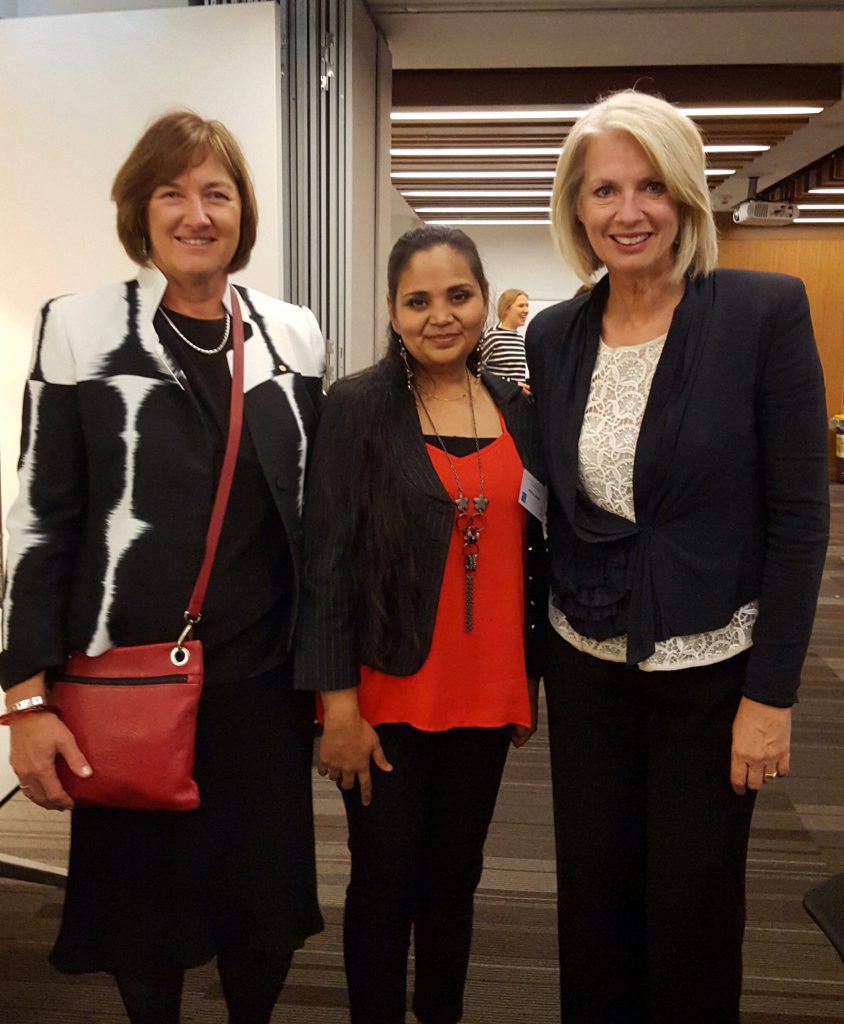
by Mubina Jamdar Female Genital Mutilation is child abuse and a form of gender-based violence in the name of religion: This was the clear message that emerged from the panel discussion held at The Australian Human Rights Commission office in Sydney on April 29, 2016. The event, hosted by No FGM Australia, was titled “FGM is Everyone’s Business”, and I had the honour of speaking on the panel on the subject of khatna (female circumcision) in the Dawoodi Bohra community. FGM is illegal in many countries around the world, including Australia. In November 2015, in one of the first convictions under Australia’s anti-FGM law, three Dawoodi Bohras were held guilty of circumcising two minor girls. Since the Bohra community predominantly comes from India, it is time for India to ban this practice and protect young girls from this barbaric practice. At the Sydney event, speakers included internationally-renowned Professor Gillian Triggs, president of the Australian Human Rights Commission, Felicity Gerry QC, international expert in FGM law, and other FGM experts including researchers, health professionals, educators, law enforcement agency and social workers. Here is a summary of key points that the panel raised: FGM, depending on the severity of the cutting, can lead to many serious health issues, even death. It causes lifelong psychological scars and for some, it leads to serious mental health issues. It’s easy to stop the practice in the family if the man takes a firm stand. Women often find it difficult to convince in-laws. Therefore, educating men is equally important. No Islamic scholar has cited any Quranic injunction advising female genital cutting. It’s a cultural practice that existed long before Islam. FGM is an issue of child abuse and child protection. For that reason, this should be made illegal under the same provisions. Australia has a large population from African countries, Malaysia, Indonesia, Egypt, middle eastern countries and many other countries where FGM is prevalent. Education is the key, at the school level and in the affected community. Spiritual leaders around the world need to give a joint statement to stop the practice. FGM is everyone’s business. My speech was aimed at educators, community workers and law enforcement agencies. I gave them insights into the community culture to help design future educational programs. I suggested the need to emphasize in education programs that FGM is not a teaching of the Quran or the Prophet, Rasulullah. Since this community is tightly controlled by the clergy and its head office in Mumbai, it is not sufficient to educate community members. Amils (Priests) should be held responsible by law to discourage community members from practicing FGM. They must report incidents of FGM to the police. How can you help? Please sign the petition to make FGM illegal in India, addressed to the Minister of Women and Child Welfare. It was launched by “Speak out on FGM” on Change.org:https://www.change.org/p/end-female-genital-mutilation-in-india [Photo courtesy: No FGM Australia]
Joint statement on Syedna Taher Fakhruddin’s stand against khatna
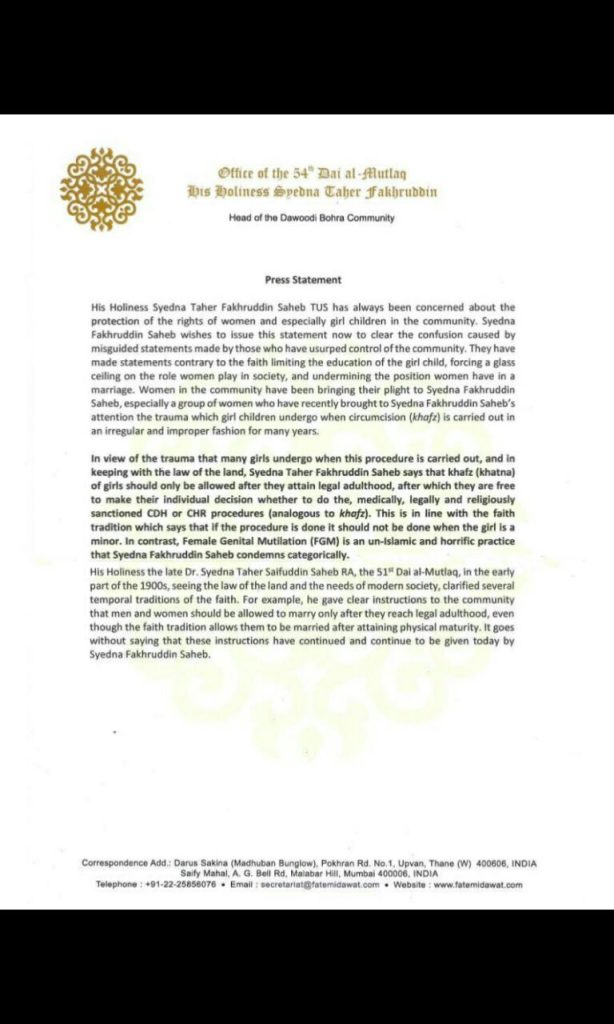
Bohra men must speak up to save their daughters from female circumcision
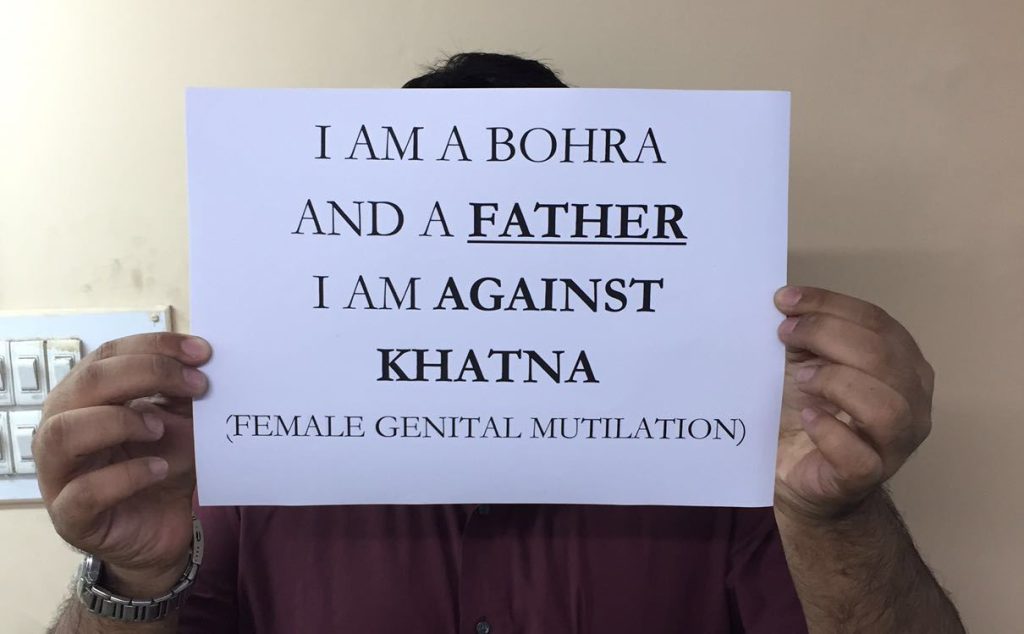
Name: YusufCountry: India The fatwa given during the Zikra majlis by Syedna Mufaddal Saifuddin in favor of female genital cutting dug up the wound that exists in my heart which makes me write this post. Looking at parts from the audio clip leaked from the majlis, at one point, Syedna Mufaddal Saifuddin says what translates to English as: “It must be done. If it is a man, it can be done openly and if it is a woman it must be discreet. But the act must be done. Do you understand what I am saying? Let people say what they want.” The Syedna made no direct mention of the word “khatna” or “khafz”, but asks that the act be done discreetly for girls so that the community does not get tangled in any legal trouble. He cryptically says, “Do you understand what I am saying?” It was a clear reference to female genital mutilation (FGM). It is obvious that this was in response to the raging debate on FGM that has occurred in public after three Bohras were convicted in Australia for practicing khatna on two minor girls. No one from the clergy has come forward to participate in this debate, and the Syedna in his fatwa said, “We are not willing to talk to anyone on this issue”. The reason this issue dug up a wound in my heart is that a couple of years ago my daughter was made to undergo this barbaric ritual, against my wishes, under pressure from family elders and the ladies in particular. A year before my daughter turned seven, my wife told me that when our daughter turns seven we have to do her khatna. Unlike most men in the community, I was aware of what khatna or FGM is and I told her that I will not allow this. I told her this practice was started centuries ago by Bohras who wanted to curb the sexual desire of their women, as they frequently travelled for business. I told her that there is no scientific/medical basis for khatna or FGM. There is no mention of it in the Quran and that other Muslim sects do not practice it. I even told her that it is illegal in the western world and has been declared a violation of human rights by the United Nations. What I also did was initiate a discussion within my close Bohra friends group. I raised the issue as to why a girl who doesn’t understand what is going on or what’s being done to her has to go through this, especially when the ones taking her for the cut are people she trusts. One reply I received from a female friend in the group is etched in my memory. She said, “Would you want your daughter to have multiple sex partners and have extra marital affairs?” I was taken aback by the reply, particularly as this friend is a well-educated person otherwise! It left me in despair on realizing the extent of falsehoods that have been propagated within the community, with people being brainwashed into believing something as barbaric as khatna, which has no scientific basis and is a violation of human rights. Forcibly doing something that is thought to curb sexual desire is in itself a violation of human rights. If educated young women of the community think in this manner, what to say of the elders who still dominate decision making in the majority of Bohra households? My wife agreed with me and was reluctant to put our daughter through the horror. She told my mom and her mom that I was against the decision. She was told by both that there would be no argument and that this centuries-old practice has to continue just like how they went through it. I being the only son, live with my parents. My wife was torn between me on one side and my mother and her mother on the other. Talking to my parents did not help and ended with the usual invocation that it’s a “religious obligation”, Moula, tears, emotions etc. My wife and I left the matter there hoping that when the time came, we could fake it. But, when my daughter turned seven, my mom said she would accompany us to take our daughter to get her khatna. She wouldn’t let us go alone. She made sure the appointment with a Bohra gynecologist (sigh!) was made. My daughter was put under the blade. The fault is mine. Maybe I wasn’t strong enough or forceful enough then to prevent that atrocity on my daughter. But, now that there is a perfidious attitude where on one hand there is this fatwa in favor of the practice, while on the other hand, jamaats in Western countries have issued letters telling citizens to refrain from the practice, I thought it is time we men from the community spoke out against it. It is time for Bohra men to be informed about this evil practice and come out against it to save their daughters. As it is well-known that the consequences of openly raising your voice against the Syedna has dire consequences, it is going to be difficult to get rid of this practice by mobilizing support from within the community. Some people may be against it, but they don’t say it openly. In my opinion, building support in the larger civil society and legal recourse is the best way to end the practice. Maybe a public interest litigation (PIL) in India will get positive result. There is already a raging debate in India over triple talaq after a lady filed a PIL against it, and it has got larger public attention and support. I commend the members of Sahiyo who are fighting against FGM. This post is my small contribution in support of their effort for a common good. ~ Written by Yusuf, a guilt-ridden and remorseful father belonging to the Dawoodi Bohra community
Respected Syedna, we are all disappointed by your views on female circumcision
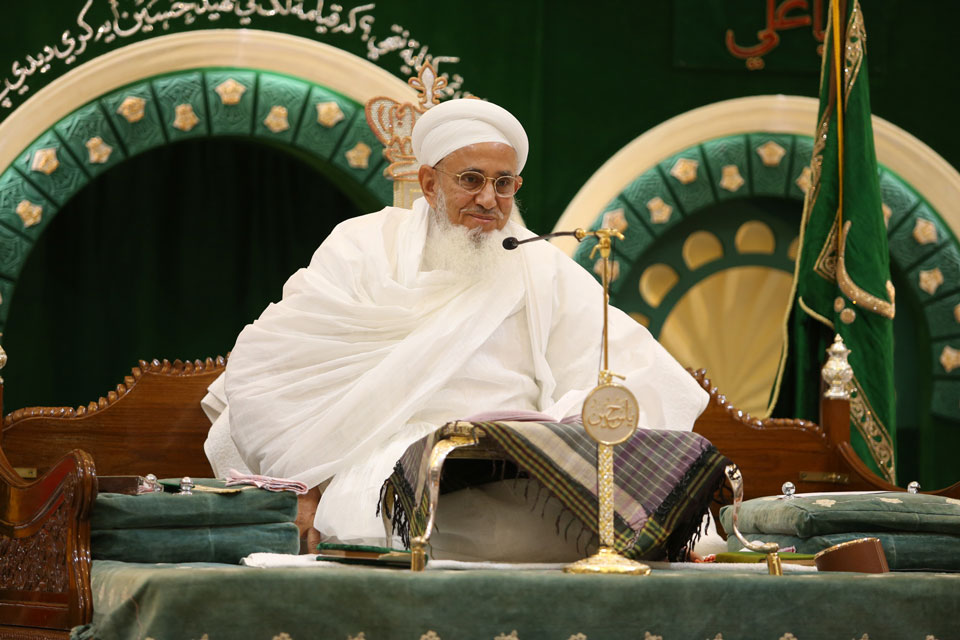
Syedna Mufaddal Saifuddin’s recent wa’az (sermon) in Mumbai has come as a disappointment. For almost three months now, Dawoodi Bohras who wish to see an end to female circumcision (khatna) had been hopeful. Starting with Sydney in February, many Bohra jamaats in different cities around the world have issued letters to their members, asking them to stop practicing khatna because it is against the law in those countries. (Read more about the jamaat letters here.) The jamaats issuing these letters – be it in Australia, USA, UK or Sweden – are all trusts that function with the sanction of the central Bohra leadership, whose headquarters are at Badri Mahal in Mumbai. The jamaat letters gave hope to Bohras across the world, even in countries like India and Pakistan where there are no laws against female genital cutting, that the Bohra leadership would eventually ask the whole community to stop practicing khatna. After all, in a community that is so close-knit and centralised, why should girls in some parts of the world be spared from circumcision, while girls in other countries continue to be cut? If Dawoodi Bohras are one community, how can there be different rules based on geography? In this light, the Syedna’s recent public sermon on April 25 has left large sections of Bohras surprised and disheartened. His speech, given at Mumbai’s Saifee Masjid on the occasion of the death anniversary of 51st Syedna Taher Saifuddin, made an indirect but fairly clear reference to khatna. A four-minute audio clip of that section of the sermon has been circulating among Bohra social media groups all week, and several concerned community members wrote to Sahiyo to tell us that they had attended the wa’az and were shocked by the Syedna’s statements. On April 29, The Times of India wrote a report about these statements, which can be read here. In the sermon, delivered in the Lisan-ul-Dawat language, Syedna Mufaddal Saifuddin can be heard saying the following: [blockquote]“Whatever the world says, we should be strong and firm…whatever they say, it does not make a difference to us, we are not willing to accept [what they say]…we are not willing to talk to them. What are they telling us? That what we are doing is wrong?…who are they to teach us?”[/blockquote] The Syedna then makes a reference to other vices that people have, such as drugs or cigarettes, asking, “Why don’t they tell those people [that they are wrong]?” A clearer reference to khatna comes with the following words in the speech: [blockquote]“It must be done. If it is a man, it can be done openly and if it is a woman it must be discreet. But the act must be done. Do you understand what I am saying? Let people say what they want…but Rasoolullah [Prophet Mohammed] has said it…Rasoolullah will never say anything against humanity. He has only spoken [of] what is beneficial…from the perspective [“haisiyat”] of the body and the soul. What do they say?…that this is harmful? Let them say it, we are not scared of anyone.”[/blockquote] The Syedna’s sermon is significant for many reasons. This is the first time that he has made such a clear reference to khatna in public without explicitly spelling it out. All through the recent Australia case hearings as well as the anti-khatna campaigns by Sahiyo, Speak Out on FGM and other Bohras, the community was eagerly awaiting a word on the subject directly from the Syedna. But his declaration that Bohras must continue the act, irrespective of opposition from various quarters, indicates that Bohra authorities were not being sincere when they issued various jamaat letters around the world. The implication of his speech is that the jamaat letters asking people to stop khatna are insignificant – a mere formality to save Bohras from facing criminal consequences in countries where female genital cutting is illegal. Were the jamaat letters a mere pretence to hoodwink international governments? His speech says “the act” must be done openly for men and discretely for women. Why? The Syedna says that the “the act” must be practiced because the Prophet recommended as something beneficial. But according to the jamaat letters issued with the sanction of the Syedna, the Prophet also preached the value of “hibbul watan minal imam” – love and loyalty for the laws of one’s country. So which teachings of the Prophet must Bohras in those countries follow? Most significantly, we would like to point out one thing: the Syedna’s speech dismisses and rejects all opposition from “them”, from all those saying that khatna is harmful and must not be practiced. The “they” he is referring to, however, are not just governments of countries like Australia or the USA. The strongest form of opposition to khatna is now coming from within the community – from Bohra women who have either undergone khatna or have seen their loved ones go through it, and from Bohra men who are horrified that their daughters, sisters, mothers and friends have to go through the cut. These are Bohras of all hues – staunch believers, regular masjid attendees, occasional attendees, sceptics, liberals, traditionalists, reformists – but they are Bohras, and they no longer want the practice of khatna to continue. By alienating these women and men as “they”, as outsiders, the opposition cannot be wished away.Those opposed to the practice have strong reasons for their views, and we urge the Syedna and all Bohras to engage in meaningful debates and discussions on the issue, rather than trying to shut out opposition. Lastly, the Times of India report quotes a source close to the Bohra authorities, claiming that this speech was not about khatna and has been misinterpreted. However, hundreds of Bohras have interpreted his speech as a reference to khatna and circulated the audio clip widely. If the leadership believes that all of these people misinterpreted the speech, we urge the Syedna to publicly clarify this, and make his stance on khatna clear.
Human Rights Day panel at New England School of Law

On March 10, 2016, Sahiyo Co-founder Mariya spoke at the New England School of Law for the event: Human Rights Day Panel: A Poignant Discussion on Female Genital Mutilation. Prior to the beginning of the event, the panel organizers played the Hindustani Times news report FGM: India’s Dark Secret to provide context that FGM/C is more global issue than previously acknowledged. In acknowledging the global nature of FGC, currently, the state of Massachusetts in the United States is in the process of passing legislation criminalizing all forms of FGC with the bill – “An Act Establishing Civil and Criminal Penalties for Female Genital Mutilation” (House Bill H1530; Senate S1116). Other speakers on the panel included members of the Massachusetts FGM Task Force who have been diligently working on the FGC issue for number of years. These members included Katie Donahue Cintolo, Women’s Bar Association and Susan McLucas, director of Sin Saunuman (Health Tomorrow) organization. Professor Dina Francesca Haynes, a human rights lawyer and professor at the New England School of Law who has worked on hundred of FGC cases also spoke.The event was presented by the International Law Society and sponsored by the Immigration Law Association, the Charles Hamilton Houston Enrichment Program, and the Center for International Law and Policy.
